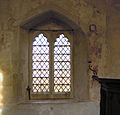Church of St Vincent, Newnham facts for kids
The Church of St Vincent is a very old church located in Newnham, England. It was built way back in the 1100s! This church is a special Grade II* historical site, which means it's important to protect. It's named after Saint Vincent. The church is famous for its amazing old wall paintings, called the Newnham Murals, which were found in 1963.
Contents
History of St Vincent's Church


St Vincent's Church was officially opened by a bishop named Herbert de Losinga. The church is built from a soft type of stone called clunch. Over the years, parts of the church were updated. The main part, called the nave, might be from the 1100s. The chancel, which is the area around the altar, was rebuilt in the early 1200s.
Changes Over the Centuries
The south aisle and the west tower were added around the 1340s. Later, from 1420 to 1440, a person named John of Wheathampstead, who was an important abbot, made more improvements. He likely added the eight-sided baptismal font, the large east window, and the south porch. You can still see small pieces of stained glass from the 1400s in some windows. The church was also repaired in 1881.
Ancient Graffiti and Markings
Because the church is made of soft clunch stone, people carved into its walls a long time ago. You can still see some of this old "graffiti," especially near the main door. Many of these carvings are votive crosses. These were made by Mediaeval pilgrims and travelers who visited the church. They might have been on their way to the Abbey at St Albans. You can also spot clearer carvings of a fish and a windmill near the belfry door.
Memorials and Special Items
Inside the church, there are two old metal plates called monumental brasses. One is from 1607 and shows a woman named Joan Dowman with her children. The other is from the early 1500s and shows a man with his two wives. There are also other memorials on the walls and floor from the 1600s and 1700s. A special embroidery, which used to belong to a historian named Reginald Hine, is now displayed in the church to remember him.
The Church Bell
The church tower only has one bell, even though there's space for four. This bell is thought to be from the late 1500s. Local stories say that two other bells from St Vincent's were sold to nearby churches many years ago.
The Newnham Murals
In the Middle Ages, it was common to decorate the inside of churches with paintings. These paintings often showed Bible stories, pictures of saints, or moral lessons. However, during the English Reformation in the 1500s, many of these paintings were covered up with whitewash. Sometimes, Bible verses were painted over them instead.
Discovering the Hidden Art
In 1963, old wall paintings were found on the north wall of St Vincent's Church. Experts believe these paintings are from the 1300s and 1400s, and some might even be from the 1200s. It looks like the entire wall was once covered in art.
The St Christopher Painting
The best-preserved painting is directly across from the entrance. It shows the lower half of Saint Christopher, including his feet, the bottom of his staff, and some cliffs with fish in a stream. On the right side, you can see the stream's banks. On the left, there's a faint image of a hermit with a lantern, guiding the saint. This painting is from the late 1400s and uses soft colors like red, yellow, gray, and black. The top part of the painting, which showed St Christopher carrying the infant Christ, was accidentally damaged in 1881.
Other Mural Fragments
Next to the St Christopher painting, there's a small piece showing a wheel design with mysterious creatures. To the east of the nave window, near the pulpit, you can see a hooded human figure. This part might have been from a Doom Painting, which showed the Last Judgement. You can also spot a unique consecration cross on the southeast side of the stair turret.
Gallery
-
Fragment of a Mural of Saint Christopher
-
Fragment of a Doom Painting of the Last Judgement












